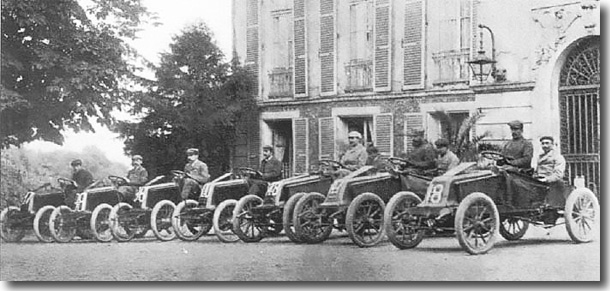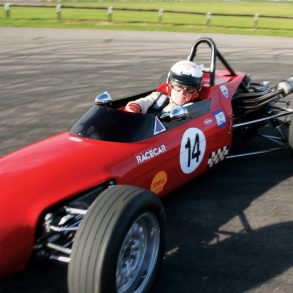Renault 1906
Car: Renault 1906 / Engine: 4 Cylinder In-line / Maker: Renault / Bore X Stroke: 160 mm X 150 mm / Year: 1906 / Capacity: 12,986 cc / Class: Grand Prix / Power: 90 bhp at 1,200 rpm / Wheelbase: 114.25 inches / Track: Front: 53.2 in Rear: 50.5 in
The Renault company had been founded in 1899 by Louis Renault and his brothers Marcel and Fernand. Louis and Marcel had immediately seen the marketing value in motor racing and their successes in the town-to-town races made the name Renault famous throughout France. In 1903 disaster struck at the infamous Paris – Madrid race when Marcel and nine others met their end. Louis, distraught declared that while his company would continue to compete he himself would never race again.
In June of 1906, the Automobile Club of France, after many disagreements with the organizers of the Gordon Bennett Races held their own race. The first Grand Prix for manufactures would be run over a 64-mile triangular course 130 miles west of Paris near the quiet town of Le Mans with the Bollee automobile factory close by. Route 23 – the Paris road – was the scene of the start. Each leg of the course was approximately 20 miles in length with sharp corners at La Ferte Bernard, St Calais and St Mars-le-Briere. In a couple of places short sections of wooden track connected the roads. Forty miles of barricades were constructed to control the spectators with a tunnel under the race track to allow safe passage. The cars had to run 12 laps, 6 laps on Tuesday 26th and 6 laps on Wednesday 27th.
There were a total of 32 starters from 12 manufacturers, three cars each from Brasier, Clement-Bayard, Darracq, FIAT, Hotchkiss, Lorraine-Dietrich, Itala, Mercedes, Panhard and Renault along with single-car entries from Gobron-Brillié and Gregorie. Each team had a number with a letter identifying the individual cars. The red painted Renault cars had the codes 3A, 3B and 3C to be driven by Szisz, Edmond and Richez.
For this race Renault built a new car around their 1905 engine. The cars were built under a new formula that called for a maximum weight of 1000 kg. Three cars could be entered by each manufacturer, operated by a crew of two, both were permitted to drive. Fuel consumption was limited to 30 liters/100 km. The shaft driven car that Renault built was not the most advanced car entered but it had two distinct advantages. One was the first use of hydraulic dampers on a race car and the second more important advantage was the adoption of rear wheels with removable rims by Michelin.
The French rubber company had first patented removable tires back in 1891. Putting tires filled with air, not to mention ones that were removable was a bridge too far for Emile Levassor of Panhard & Levassor in 1895. By 1906 the removable tires were used by many of the top riders … of bicycles but for race cars they were still controversial. While the filling of tires with air had been long since accepted it was thought that the removable rims would not hold up to the strains of automobile racing. But nobody could deny the fact that the new rims allowed two people the ability to change both rear wheels in less than 4 minutes as opposed to more than 16 minutes required by fixed rims.
Renault’s driver in the Grand Prix was Ferenc Szisz, a native of Hungary, who had served as Louis’ mechanic at the fateful Madrid race and who now served as Renault’s chief test driver. During the race he had to stop nine-times due to tire punctures yet because of the removable rims he was able to finish exhausted but thirty-two minutes ahead of the second place Nazzaro in a Fiat.














